Join More Than 50,000+ Subscribers and get latest camera news and rumors
NEW CAMERA VIDEOS ON YOUTUBE
Download Our Android App
|
By admin, on May 25th, 2024
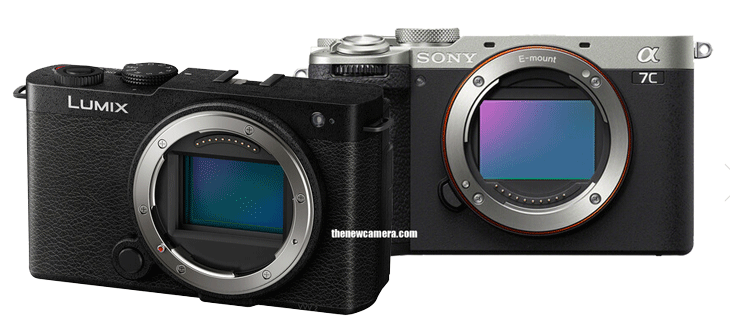
Let’s compare the Panasonic S9 versus the Sony A7C II. Starting with the comparison,
1. Sensor
we know the key difference here is the sensor resolution. Both cameras feature BSI CMOS sensors, but the Sony A7C II has a 33-megapixel Exmor R BSI CMOS sensor, whereas the Panasonic S9 uses a 24.2-megapixel sensor BSI CMOS. If we compare them side by side, the Sony A7C II will show slightly more details due to the higher-resolution sensor, specifically when you are pixel-peeping at 100% scale, as many of us do as photographers. However, the difference is minimal and not noticeable until you test both images under lab conditions.
2. AutoFocus
The autofocus sensitivity of both cameras is slightly different. The Sony A7C II’s autofocus sensitivity range is -3 EV to 20 EV, whereas the autofocus sensitivity range of the Panasonic S9 is from 0 to 18 EV., so Sony A7C II II practically more usable in low-light condition compared to the S9
3. AI integration
Regarding AI integration, the Sony A7C II camera is more advanced, with a dedicated AI chip inside it as well as dedicated AI alkgo. The autofocus capability and tracking performance of the A7C II is better compared to S9, and it can track subjects like trains, airplanes, and other moving objects. This doesn’t mean the Panasonic S9’s autofocus system is inferior or bad; it is quite good since Panasonic also uses a hybrid autofocus system. However, if you compare it with Sony, you will notice some differences. however, the S9 camera sensor is also very suitable for general-purpose photography and usage.
| Feature |
Panasonic S9 |
Sony A7C II |
| Sensor Type |
BSI CMOS |
BSI CMOS |
| Sensor Resolution |
24.2 megapixels |
33 megapixels |
| Detail Level at 100% Zoom |
Lower detail |
Higher detail |
| Autofocus Sensitivity Range |
0 EV to 18 EV |
-3 EV to 20 EV |
| AI Integration |
No dedicated AI chip |
Dedicated AI chip |
| Autofocus Capability |
Good, hybrid autofocus system |
Superior, advanced tracking performance |
| Tracking Performance |
Efficient but slightly lower than Sony |
Excellent, tracks moving objects efficiently |
| General Photography Usage |
Suitable |
Suitable |
3. Mechanical Shutter vs Electronic
Sony A7C II camera has two options: one is a mechanical shutter and the other is an electronic shutter. The Panasonic S9 remains limited to electronic only. With the help of a mechanical shutter, you get a mechanical range starting from 1/4000 of a second to 30 seconds long exposure in the Sony A7C II camera. The electronic shutter range of both cameras is the same, from 1/8000 of a second to 60 seconds. However, the Sony A7C II’s electronic shutter range limited to 1/8000 of a second to 30 seconds.
4. Continuous shooting speed
Let’s compare the continuous shooting speed with full-time autofocus support and auto exposure support. With the Panasonic S9 camera, you are able to capture approximately 30 frames per second with the help of the electronic shutter. The Sony A7C II camera’s continuous shooting speed is limited to 10 frames per second with the mechanical shutter.
5. Pre-shooting buffer
One more thing that you get with Panasonic that will help you as a photographer is a pre-shooting buffer of approximately 0.50 seconds, which effectively counts 15 frames per second in the Panasonic S9 camera, which is absent in the Sony A7C II.
6. Pixel Shift High-Resolution Mode
Advantages associated with the Panasonic S9 camera include sensor-shift high-resolution mode. With the Panasonic S9 camera, you can capture 96-megapixel high-resolution images while using this mode, but there is one condition: you have to place your camera on a tripod, and the subject should be still.
Being a Panasonic camera, you also get some abilities of post-focus mode, so you can change the focus point after taking a shot, but all these facilities are only available in RAW files, not available in JPEGs.
| Feature |
Panasonic S9 |
Sony A7C II |
| Shutter Options |
Electronic only |
Mechanical and electronic |
| Mechanical Shutter Range |
Not available |
1/4000 sec to 30 sec |
| Electronic Shutter Range |
1/8000 sec to 60 sec |
1/8000 sec to 30 sec |
| Continuous Shooting Speed |
30 fps (electronic shutter) |
10 fps (mechanical shutter) |
| Pre-Shooting Buffer |
Yes, 0.50 seconds (~15 fps) |
No |
| High-Resolution Mode |
Yes, 96 megapixels (requires tripod and still subject) |
No |
| Post Focus Mode |
Yes (RAW files only) |
No |
7. Display
Sony A7C Mark II camera features an electronic viewfinder of 0.39 inch OLED, 2.36 million resolution, whereas the electronic viewfinder is completely absent in the Panasonic S9 camera. Both cameras give you a vari-angle display screen for composition freedom, but resolution-wise, the Panasonic S9 display screen is much more powerful with a 1.84 million dot resolution compared to the Sony A7C II with 1.04 million resolution.
8. Handgrip
Body design and hand grip-wise, the Sony A7C II will give a much better experience to a professional photographer compared to the Panasonic S9. For the Panasonic S9, you have to buy an additional grip; without that, it is not able to be used properly even for 30 minutes while holding your camera with a lens. It is completely a grip-less camera.
| Feature |
Panasonic S9 |
Sony A7C II |
| Electronic Viewfinder (EVF) |
Absent |
0.39 inch OLED, 2.36 million resolution |
| Display Screen |
Vari-angle, 1.84 million dot resolution |
Vari-angle, 1.04 million resolution |
| Body Design and Hand Grip |
Requires additional grip for proper use |
Better experience for professional photographers |
| Ease of Use |
Difficult to use without additional grip |
Comfortable to use even without additional accessories |
9. Video Mode
Let’s compare the video specifications of both cameras since both cameras are made for content creators. Let’s see which camera is best for you.
Regarding recording formats in both cameras, the Panasonic Lumix S9 supports MOV format, MP4 format, and MP4 HEVC format, but is missing the All-I intra-recording format. The Sony A7C II supports the XAVC S, XAVC SI (which is All-I intra format), as well as the latest XAVC HS.
10. Video Time Limits in Panasonic S9
The Panasonic S9 can capture up to 6K video at 60 frames per second, with a maximum of 10 minutes only. After that, the recording will stop, and you have to start it again. No 6K recording video mode is available in the Sony A7C Mark II.
The Sony A7C II camera captures 4K at 60 frames per second, and the Panasonic S9 also captures 4K at 60 frames per second, but with a 1.5x crop. In both cameras, you have to face a crop while recording 4K at 60 frames per second. However, in the Panasonic S9 camera, the recording time of 4K 60 FPS videos is limited to 15 minutes only, whereas in the Sony A7C Mark II camera, you can record videos until the camera gets overheated. Additionally, since the All-I intra format is available even while shooting 4K at 60 FPS in the Sony A7C Mark II, the overall bit rate jumps to 600 megabits per second (Mbps).
The Biggest SAD part of Panasonic S9 even the Full HD video recording mode of the Panasonic S9 Camera is limited to 20 Minutes Only, its look like the Camera is only designed to serve the TIK-TOK or You Tube SHORTS Creators ONLY.
| Feature |
Panasonic S9 |
Sony A7C II |
| Recording Formats |
MOV, MP4, MP4 HEVC |
XAVC S, XAVC SI (All-I intra), XAVC HS |
| 6K Video Recording |
Yes, up to 60 fps (10-minute limit) |
No Limit |
| 4K Video Recording |
Yes, up to 60 fps (1.5x crop, 15-minute limit) |
Yes, up to 60 fps (1.5x crop, limited by overheating) |
| Maximum Bit Rate |
200 Mbps (6K/5.9K) |
600 Mbps (4K All-I intra) |
| Recording Time Limits |
10 minutes (6K), 15 minutes (4K 60 fps) |
No fixed limit (until overheating) |
| Crop Factor in 4K 60 fps |
1.5x |
1.5x |
Panasonic S9’s 6K and 5.9K recording are limited to the MP4 HEVC format, with recording going up to a maximum of 200 megabits per second (Mbps). So, that’s a very limited amount of data you are getting even when you are recording 6K or 5.9K with the Panasonic S9, and the time limit is also there of 10 minutes.
Detailed Comparison
| Camera Name |
LUMIX S9 |
Panasonic A7C MK2 |
| Audio rec. method |
MPEG-4 AVC/H.264
H.265/HEVC |
MPEG-4 AVC/H.264
MPEG-H HEVC/H.265 |
| Recording Format |
MOV
MP4
MP4 Lite |
XAVC S,
XAVC SI,
XAVC HS |
| 6K |
6K 29.97p 200Mbps
(3:2 / 17:9)
5.9K 29.97p 200Mbps
(16:9) |
– |
| 4K |
FF
4K 29.97p – 150Mbps 4:2:2, 10bit LGOP
C4K 29.97p – 150Mbps 4:2:2
10bit LGOP
APS-C – C4K 59.94p – 200Mbps – 4:2:2 10bit LGOP
4K 47.95p – 200Mbps
4:2:0 10bit LGOP |
~60p – UHD
ALL-I /LGOP
~600Mbps |
| FHD |
~119.88p – 150Mbps – 4:2:2 10bit – LGOP |
~60p
ALL-I /LGOP
~222Mbps |
| high speed |
4K APS-C 60fps
4:2:0 10bitFHD 180fps 100Mbps 4:2:0 10bit |
~120fps |
| Video Crop |
4K 60p APS-C
4K 30p Full |
None (4K 30p)
S35 (4K 60p) |
Cont. shooting
|
6K 10 minutes
4K 15 minutes
FHD 20 minutes |
Unlimited |
| Internal recording |
4K 60p 4:2:2 10bit |
4K 60p 4:2:2 10bit |
| Time Lapse Video |
correspondence |
– |
| Video rec. function |
LUT Assist
HLG Assist
Anamorphic Desqueeze..and..Timecode
Waveform
Monitor
Vectorscope
Zebra
Color
Barney
Control Red Frame |
TC/UB
Zebra
Peaking
Active Electronic IS
Hybrid AF
HLG
Proxy
AF Transition Speed
AF Shift Sensitivity
Flexible Exposure Settings
Focus Map
Breathing Compensation |
| Video Profile |
V-Log
CinelikeD2
CinelikeV2
Like709
Like2100
Like2100FL
Real-time LUT |
PP1-PP11 |
Electronic IS
|
Active IS |
Active IS |
11. Panasonic S9 Professional videography features for cinematic use
The Panasonic S9 camera uses the same software that is used in the Panasonic S5 II, so you get all the features that are present in professional cameras even though you have to face recording time limits even in Full HD. But at the same time, you are getting features like anamorphic de-squeeze, time code functionality, waveform monitor, and vector scope. These are some features that a professional may require while shooting video with a camera available in the S9. The recording time limit is two hours in full HD and should be removed.
12. Gyro-based image stabilization system and focus breathing compensation
The Sony A7C Mark II is a bit more vlogger-oriented camera. That’s why SONY is giving gyro-based image stabilization for stability in handheld V-Log. At the same time, due to the presence of a dedicated AI chip, the camera is now able to do AI auto-framing of the subjects and track the subject with its movement. And finally Focus Breathing compensation for flawless AF performance.
Verdict: Panasonic S9 Core Specs very appealing, but at the same time the time limit in video ruins everything, So Sony A7C Mark II is more recommended over the Panasonic S6
Get Sony A7C II from Amazon.com | B&H Store
By admin, on May 24th, 2024
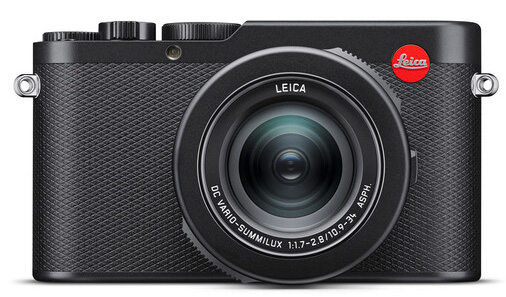
Like a D-Lux 8 finally announced, the camera features an updated menu system similar to the full-frame Q3 model and some subtle upgrades. Let’s talk about the set of camera upgrades from its predecessor. First of all, the sensor remains the same, so don’t get overexcited thinking you will get a new sensor. It has the same sensor and the same image processor. Also to be noted, the camera uses the same old DFD autofocusing system (Depth From Defocus) developed by Panasonic, so we will not be getting any hybrid SIMO autofocus sensor inside this camera. Overall, the core specifications remain similar, but Leica was able to do something related to the display portion of the camera. In the D-Lux 8, the viewfinder is upgraded to OLED 2.36 million dots, earlier the DLUX 7 had a 2.76M dot “equivalent” viewfinder, but according to LEICA the new one avoids the field-sequential tearing effect for smoother operation.
Other Updates
- Rear Screen: It boasts a higher resolution 1.84M dot (960 x 640px) rear screen, enhancing clarity and detail in image review and menu navigation.
- USB-C Charging: The new model includes a USB-C socket, allowing for convenient in-camera charging.
- Bundled Flash: The D-Lux 8 comes bundled with a flash, adding value and flexibility for low-light shooting.
Leica DLUX 8 Major Specification
- 17MP Four Thirds CMOS Sensor
- Leica 10.9-34mm f/1.7-2.8 Lens
- 24-75mm Full-Frame Equivalent
- DNG Format Support
- On-Camera Flash Included
- Leica FOTOS App Connectivity
Leica DLUX 8 Press Release
Leica DLUX8 Press Release:
Leica announces the continuation of compact digital cameras with the upcoming launch of the Leica D-Lux 8 on 2nd July 2024
Teaneck, NJ, May 23rd 2024. Leica Camera AG will launch the new Leica D-Lux 8 on July 2nd 2024. In 2003, the German premium manufacturer introduced the first D-Lux. Eight generations and numerous special editions later, the D-Lux has solidified its position in the top-quality segment of Leica’s digital compact cameras.
The new D-Lux 8 brings the quintessential Leica experience into a more compact and accessible form. The overall user experience and iconic design are a testament to the excellence of the legendary Leica brand, recognized globally as a leader in the field. For enhanced user comfort, the controls have been simplified and ergonomically repositioned, while the user interface, inspired by the popular Leica Q-Cameras, has become even more user friendly. The D-Lux 8 features a 4/3” CMOS sensor offering 21MP (effective 17 MP), the fast Leica DC Vario-Summilux 10.9–34 mm f/1.7–2.8 ASPH. lens (35mm equivalent to 24-75 mm), intuitive design and seamless connectivity with the Leica FOTOS app. The flash included with the camera further expands the versatility of the D-Lux 8.
In addition to the camera, a new range of accessories will be introduced. These include a hand grip, carrying straps, wrist straps, and leather protectors available in multiple colors. Additional accessories such as an automatic lens cap, soft release buttons, and a selection of bags, including a hip bag, crossbody bag, and equipment bag, expand the camera’s portfolio.
The Leica D-Lux 8 will be available globally on July 2, 2024 at all Leica Stores, the Leica Online Store, and through authorized dealers. The US retail price will be $1,595.
By admin, on May 23rd, 2024
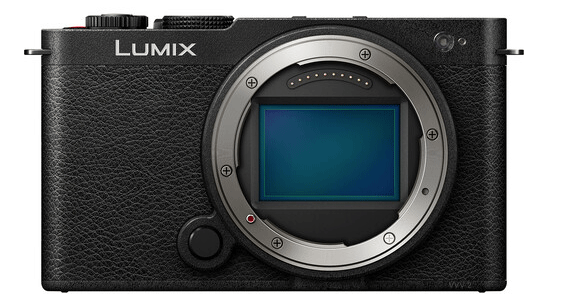
Panasonic S9 was finally announced, the camera features excellent core specifications with some limitations, we take a look at the detailed core
Get Panasonic S9 from B&H Store | amazon.com
Nikon S9 Major Specification
- 24MP BSI CMOS sensor with on-sensor phase detection
- 4K 3:2 open-gate video in 25 or 30p (4:2:0 10-bit) with new ‘MP4 (Lite)’ codec
- 6K 3:2 open-gate video at up to 30p (4:2:0 10-bit)
- 6K or DCI/UHD 4K from full sensor width up to 30p
- DCI/UHD 4K up to 60p (with APS-C crop)
- Dedicated LUT button to apply LUTs in real time (photos and video)
- Tight integration with the new LumixLab smartphone app
- Dual conversion gain sensor with explicit ‘Dual Native ISO’ gain selection
- UHS-II card slot
- 1.84M dot fully-articulating LCD
Panasonic Launches New LUMIX S9 Compact Full-Frame Mirrorless Camera, Ushering In A New Era for Seamless Content Creation
The smallest and lightest LUMIX S Series camera yet shoots and shares to social media in 30 seconds*2 with the new LUMIX Lab app
Newark, N.J. (May 22, 2024) – Panasonic is proud to announce the LUMIX S9, the smallest and lightest full-frame mirrorless camera in the LUMIX S Series. Available in four colorways–Jet Black, Crimson Red, Dark Olive, and Classical Blue–the LUMIX S9 is a stylish companion for content creators on the go and easily elevates social media content. With the introduction of the LUMIX S9 to its line-up of cameras, Panasonic aims to bring a new enjoyable shooting experience for creators, making the journey from capturing moments to sharing them with the world seamless and intuitive.
The approximately 24.2-megapixel full-frame CMOS sensor is equivalent to that of the LUMIX S5II, and the latest engine captures content in rich detail with natural tones. The full-frame sensors also deliver stunning results, even in low light conditions, and offer cinematic quality, with a beautiful bokeh effect. The camera is additionally equipped with PDAF (Phase Detection Auto-Focus), providing excellent subject tracking, as well as Active I.S., which significantly reduces blurring from camera shake even when shooting handheld, allowing users to shoot content confidently, in any situation and environment
Designed with the creative smartphone user in mind, the LUMIX S9 also grants users a range of popular, classic or bespoke color styles in-camera with the popular REAL TIME LUT function via a new dedicated button on the camera body. Furthermore, with the new LUMIX Lab app creators can develop their own unique LUT color files on their smartphone. Through these features, one can effortlessly generate original and shareable stills and videos without the need of post-production editing on a computer, expanding the scope of creative possibilities. The speed of transferring data from camera to smartphone has also been improved with the new app and the ability to pair it with a LUMIX camera.
The LUMIX S9 also introduces a new recording format: MP4 Lite. Shooting Open Gate in 4:2:0 10 bit in 30p/25p, creators can capture high quality videos in the optimum format for smartphone, and easily resize aspect ratios to suit social media with the LUMIX Lab app. With this new streamlined editing workflow, content creators can easily shoot and share while on the go.
Key LUMIX S9 Features include:
- The first compact design in the LUMIX S Series, combining a small and lightweight body with high image quality.
- Compact and lightweight body weighing approximately 403g/0.89 lb.*3
- Approx. 24.2-megapixel full-frame CMOS sensor and the latest engine deliver powerful imaging performance.
- Improved real-time recognition AF with PDAF (Phase Detection Auto-Focus) for more precise subject tracking performance.
Industry leading image stabilization technology with 5-axis Dual I.S.2: 6.5 stops*4 / Body I.S.: 5 stops*5 and Active I.S. compensate for camera shake when shooting while walking.
- Equipped with MP4 Lite, a new smartphone-optimized Open Gate video mode.
- Free-angle rear screen for flexible shooting at all angles.
- New LUMIX Lab app for effortless connection.
- Allows high-speed transfer of photos and videos from the camera to a smartphone.
- Enables users to easily create original LUT files and transfer them from a smartphone to the camera, allowing them to enjoy their own preferred color expressions.
- Quick and easy editing of MP4 Lite video files optimized for social media sharing.
- REAL TIME LUT for a wider range of creative expression
- Fully customizable LUT color files can be loaded in-camera for creative shooting
- Dedicated LUT button on the camera body for ease of use.
Panasonic will unveil the new LUMIX S9 at 2024 VidCon Anaheim from June 26-29. It will be available for purchase in late June 2024 at valued channel partners for $1,499.99.
By admin, on May 21st, 2024
There lot of discussion has been circulating on the Internet following our post where we published the registration details of three new cameras after the Z6 Mark III camera registration. This raised questions from users who commented on our website and the rumor mill, suggesting that these registrations are not new, specifically the three registrations that appeared after the Z6 Mark 3 camera. Is this true? Let’s find out.
In 2024 The 1834 Model Code Used to Register a Bluetooth Device (No WiFi inside the device )

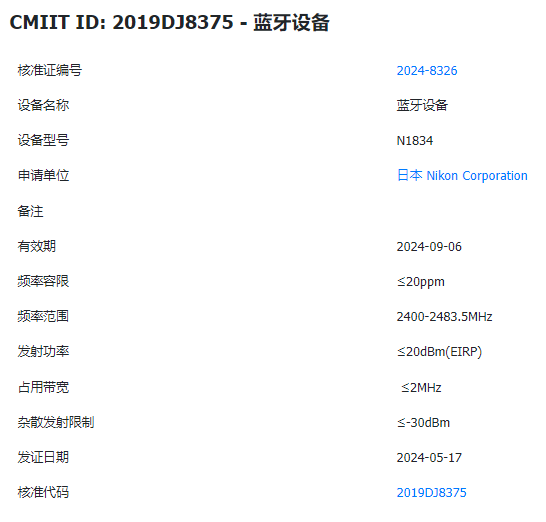
The Orginal P950 Reg Certificate shows it also has WLAN capabilities (WiFi)
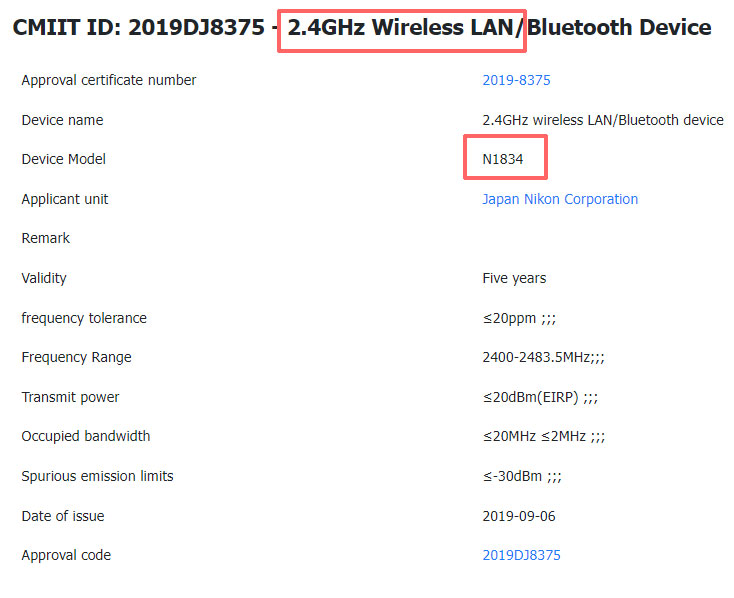
The 1834 Model Used by Nikon P950 – Digital Camera
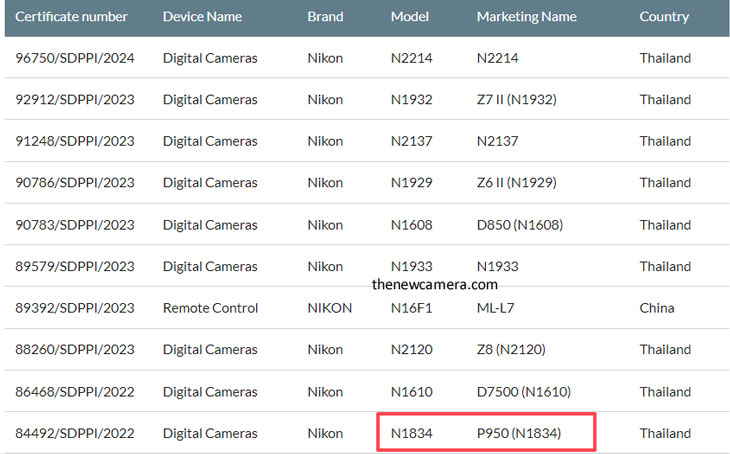
The mistake made by the camera maker, which users did not notice while pointing out that all three are older generation cameras, is the Nikon P950 registration model code name, 1834, which was registered back in 2022 with WiFi – WLAN 2.4 Ghz. Nikon has used the same model code to trick us, but the major mistake they made was using that particular model code for a Bluetooth device in 2024. If they were renewing a particular product, both products should share similar wireless capabilities, but the new N1834 mode doesn’t have WiFi inside it,. It’s very clear from this incident that the camera maker is reusing its old model codes for their new products. This particular incident reveals their future strategy. I hope this clears up any confusion.
And yes, there is a strong chance that all three models are old and Nikon is just upgrading the certification time, let’s hope for the best.
Follow us on our social pages FACEBOOK | TWITTER | INSTAGRAM to get live news + Nikon Rumors 24X7.
By admin, on May 20th, 2024
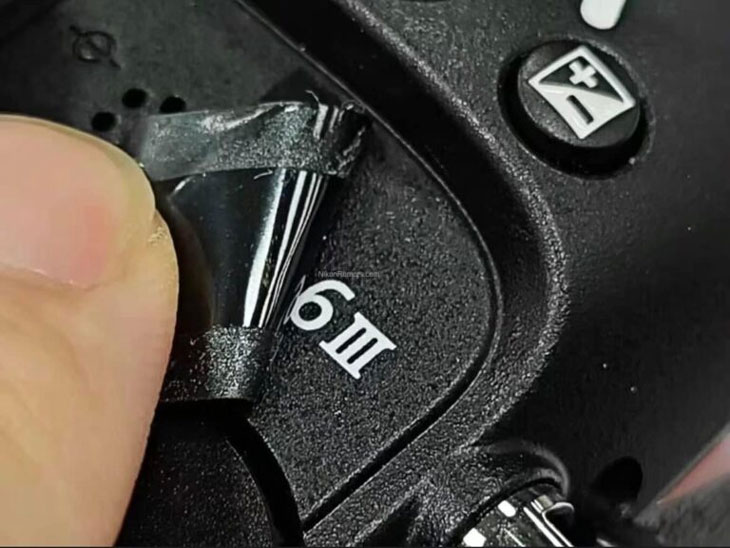
We have sorted out the list of Nikon cameras registered with the wireless certification agency, so in total we have FOUR registered cameras waiting to arrive in the year 2024. One of these cameras is without a doubt the Nikon Z6 Mark III, which is about to arrive soon within a matter of weeks. The next two cameras are unknown, but if you look at the details, it looks like they are also high-end cameras, not kind of entry-level, based on the initial wireless specifications they have on their registration page.

Nikon Z6 Mark III + 3 More ?
Among these two cameras, one can be the Nikon Z7 Mark III since, in general, we have seen that Nikon updates both cameras together. Hence, the Nikon Z6 Mark 3 is expected to arrive alongside the Nikon Z7 Mark 3.
The next camera, the third one, is completely unknown. A wild rumor has hit our mailbox that Nikon is also preparing to announce a direct competitor to the Canon R3 camera before the 2024 Olympics. This seems quite illogical to me since we already have the Z6 Mark 3 camera and the Z7 Mark 3. Expecting another high-end camera just after the announcement of the Z6 Mark 3 is unacceptable to me.
The Fourth one, again completely wild guess it’s the Nikon Z90, all the cameras we have discussed coming out from this list of Upcoming Nikon Cameras 2024
Registered Camera details



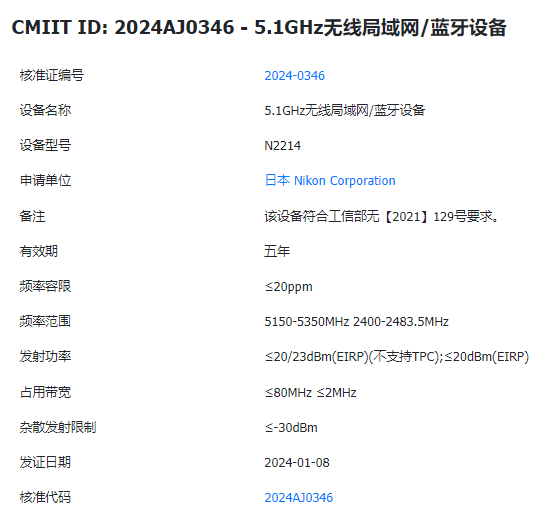
This post was first published on thenewcamera.com website
Follow us on our social pages FACEBOOK | TWITTER | INSTAGRAM to get live news + Nikon Rumors 24X7.
By admin, on May 18th, 2024
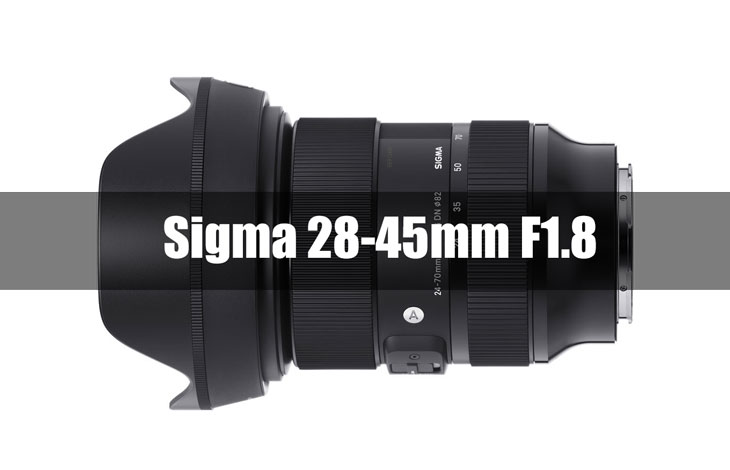
According to the latest rumors we have, Sigma is planning to announce a constant aperture zoom lens very soon for full-frame cameras, initially, it will be available for Sony E-Mount and L-Mount. The focal length of the lens is said to be 28 – 45 mm, and it will maintain a constant aperture of f/1.8 through the zoom range., so, that is an excellent move by Sigma, and I do hope and expect Tamron will also follow the same and soon announce some band new F1.8 Zoom Lenses for their FF Cameras.
Sigma was very popular with its APS-C DSLR lens, the 18 to 35 mm f/1.8, Let’s hope and expect after the announcement of the 28-45mm F1.8 Lens they should re-announce the same lens for Mirrorless mount too.
According to the information, the lens is specifically designed for video and content creation purposes as well as pro photographers, will you buy this lens let me know
also see – Sony ZV-E10 Mark II Specification
Follow us on our social pages FACEBOOK | TWITTER | INSTAGRAM, If you have time –>see more Camera News and Sony Alpha Rumor
source SAR Youtube
By admin, on May 16th, 2024
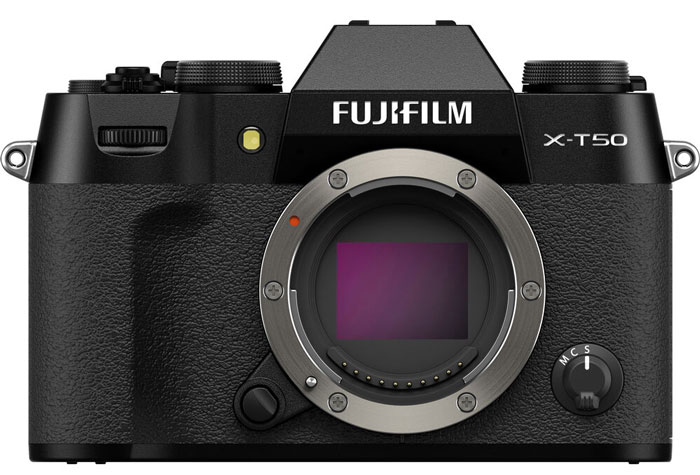
Finally, the Fuji XT50 camera has been announced. The camera features the same 40-megapixel sensor and the ability to record 4K video up to 60 frames per second, and full HD video up to 40 frames per second, as we have told you in the past. The camera features exceptional core specifications and its price makes it the first Fuji entry-level XT series camera to feature sensor-shift image stabilization. Take a look at the details in the press release and the major specifications of the camera.
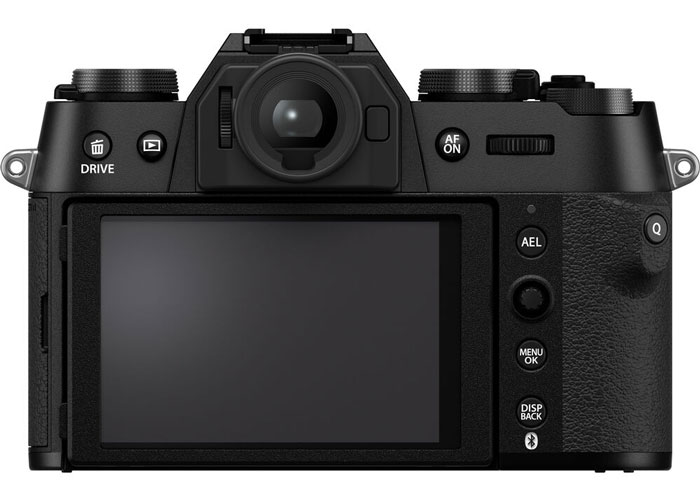
Fuji X-T50 Camera Major Specification
- 40.2 million pixel X-Trans CMOS image sensor
- X-Processor 5 processor
- 425 focus points
- 3-inch tilting touch LCD screen
- Mechanical continuous shooting speed of 8fps, electronic continuous shooting speed of 20fps
- Body stabilization up to 7 stops
- Built-in 1.4x / 2.0x digital teleconverter
- Body film filter dial
- 20 film filters
- Single UHS-II SD memory card slot
- NP-W126S battery, capable of shooting approximately 390 images
- 6.2K30p, 4K60p video recording
- F-Log2, ProRes, and BlackMagic RAW
- Available in black and silver body colors
Fuji X-T50 Latest Price
Fuji X-T50 pre-order from B&H Store
Fuji X-T50 Camera silver edition [ordered from here]
Fuji X-T50 with 15-45 F3.5-5.6 [B&H Store]
Fuji X-T50 + XF 16-50mm F2.8-1.8 Lens [B&H Store ]
Fuji X-T50 Press Release
Calling All Creatives: Fujifilm Announces FUJIFILM X-T50 Mirrorless Digital Camera and FUJINON XF16-50mmF2.8-4.8 R LM WR Lens
Latest X Series Camera and Lens Offer Solutions for Creatives on the Go
VALHALLA, N.Y., May 16, 2024 – FUJIFILM North America Corporation, Electronic Imaging Division, today announces the launch of its FUJIFILM X-T50 mirrorless digital camera (X-T50), designed with the similar manual controls and classic camera styling of FUJIFILM X100VI and other X100 Series fixed-lens cameras, but with the flexibility of interchangeable lenses for those who seek added versatility in their everyday carry camera. Also introduced today is FUJINON XF16-50mmF2.8-4.8 R LM WR lens (XF16-50mm) featuring a versatile focal length range, making it suitable for a broad range of applications, from wide-angle landscape and architectural photography to portrait photography. With their lightweight designs and compact form factors, these new X Series innovations are designed for active image makers.
“Passionate creatives are ready to grab their gear and create content at any given moment,” said Victor Ha, vice president, Electronic Imaging Division and Optical Devices Division, FUJIFILM North America Corporation. “X-T50 and XF16-50mm are made to be everyday-carry items; lightweight, comfortable tools that can be thrown in a bag for folks that are on the move. X-T50 is a great example of how we are keeping creativity top of mind for our users. From the dedicated Film Simulation dial to AI-based subject detection autofocus, X-T50 is more than ready the moment inspiration of any kind strikes.”
X-T50 Mirrorless Digital Camera
Dedicated Film Simulation Mode Dial
- For the first time on any X Series camera, X-T50 features a dedicated Film Simulation dial for fast, easy access to a wide variety of Fujifilm Film Simulations. There are a total of 20 Film Simulation modes available for X-T50 including the recently introduced REALA ACE mode, which combines true-to-life color reproduction and crisp tonal gradations. The new Film Simulation dial is incorporated on the top plate, allowing users to intuitively switch between the included Film Simulation modes with ease.
40.2 Megapixel X-Trans CMOS 5 HR Sensor
- X-T50’s compact and lightweight body weighs approximately 438 grams (15.45 ounces)1, and features the X Series’ popular back-illuminated 40.2 megapixel X-TransTM CMOS 5 HR sensor and the high-speed image processing engine X-Processor 5. The latest image processing algorithm in the fifth generation X Series cameras delivers high resolution while maintaining a high signal-to-noise ratio. X-T50 is compatible with all X Series lenses, and the sensor’s high pixel count of approximately 40.2 megapixels is maximized by the digital teleconverter function2, allowing images to be magnified by either 1.4x or 2x. X-T50’s pixel structure allows light to be captured efficiently; with ISO 125, the electronic shutter can be set to a shutter speed of up to 1/180000 second, achieving highly precise control of exposure time.
In-body Image Stabilization (IBIS) and Auto mode
- X-T50 is equipped with a 5-axis IBIS function with a maximum of 7.0 stops3. While maintaining the mobility that has been a key feature of previous X Series models, X-T50 enables comfortable, hand- held image making, even in low light. Equipped with an AI-based subject detection autofocus (AF) developed using deep learning technology, X-T50 can detect animals, birds, cars, motorcycles, bicycles, airplanes, trains, insects, and drones4. When in Auto mode, X-T50 detects the subject and tracks it while keeping it in focus, making it easy to create high-quality still images and movies.
6.2K/30P and 4K/60P video capabilities
- For video creators, 6.2K/30P recording is available. Tracking AF functionality is also available for high-quality video recording.
- X-T50’s extensive 13+ stop dynamic range on F-Log2 is perfect for color grading.
Sophisticated product design
- X-T50 features a 1.84 million-dot, tiltable rear LCD monitor inside a new, rounded body and grip, designed to fit comfortably in the hand while maintaining a compact size.
- A pop-up flash integrated into the viewfinder is mounted on the top plate, automatically controlling the amount of light needed for dark scenes and backlit portraits.
Native Frame.io Camera to Cloud Connectivity
X-T50 offers an accessory-free, native Camera to Cloud integration for Adobe’s Frame.io, which allows users to wirelessly connect any X-T50 to an active internet connection, authenticate it to Frame.io, and automatically upload photos and videos just moments after they are created. This can drastically reduce the amount of time needed to reach the end of any post-production workflow. X-T50 is the latest X Series camera to integrate Frame.io’s Camera to Cloud technology, joining FUJIFILM X-H2, FUJIFILM X-H2S, FUJIFILM X-T5, FUJIFILM X-S20, and FUJIFILM X100VI mirrorless digital cameras in offering the capability.
FUJINON XF16-50mmF2.8-4.8 R LM WR Lens
XF16-50mm is a standard zoom lens that covers a focal length range from wide-angle 16mm (equivalent to 24mm in 35mm format) to medium telephoto 50mm (equivalent to 76mm in 35mm format). It offers high-speed and high precision autofocus, with magnification of 0.3x at the telephoto end (equivalent to magnification of 0.45x in 35mm format), allowing the user to get as close as approximately 4cm (1.4 inches) in minimum focusing distance throughout the zoom range and as close as 15cm (approximately 6 inches) from the front of the lens to the subject.
XF16-50mm features a weather resistant structure (weather sealing applied to 13 areas of the lens barrel) and is temperature resistant down to -10 degrees Celsius (14 degrees Fahrenheit), allowing for versatile use in a wide range of scenes.
Adopting a lens configuration of 9 groups and 11 elements, including 3 aspherical lenses and 3 extra- low dispersion (ED) lenses, XF16-50mm suppresses chromatic aberration and maintains high- resolution performance throughout the zoom range. In addition to its high-resolution performance, XF16-50mm also has a close-up capability equivalent to roughly half that of macrophotography in 35mm format, making it effective for photographing food, crafts, plants, and various everyday scenes.
Product Features
Lightweight Design
- By optimizing the placement of the lens, XF16-50mm has a weight of approximately 240 grams (8.5 ounces), making it the lightest zoom lens in the XF lens lineup to date.
- The constant-length design, in which the lens does not extend during zooming, provides a truly comfortable zoom operation for users.
Fast and accurate Autofocus
- XF16-50mm uses the inner focus method, which drives a compact and lightweight group of focus lenses with a linear motor. In addition, the high-speed and high precision autofocus system, achieved through the miniaturization of the focus lens group, creates accurate AF within approximately 0.015 seconds5.
Pricing and Availability for FUJIFILM X-T50 and FUJINON XF16-50mm
FUJIFILM X-T50 digital camera will be available in Black, Charcoal Silver, and Silver with expected availability in June 2024 at a Manufacturer’s Suggested Retail Price of $1,399.95 USD ($1889.99 CAD). Additionally, Fujifilm plans to introduce a kit featuring X-T50 and FUJINON XC15-45mmF3.5- 5.6 OIS PZ lens, at a Manufacturer’s Suggested Retail Price of $1,499.95 USD ($1,999.99 CAD).
FUJINON XF16-50mmF2.8-4.8 R LM WR lens is also expected to be available in June 2024, at a Manufacturer’s Suggested Retail Price of $699.95 USD ($949.99 CAD).
Alongside the release of the FUJINON XF16-50mmF2.8-4.8 R LM WR lens, Fujifilm plans to introduce kits featuring this lens with its FUJIFILM X-T50, FUJIFILM X-T5, and FUJIFILM X-S20 mirrorless digital cameras, each of which feature in-body image stabilization designed to maximize the lens’s performance. Manufacturers Suggested Retail Price of the X-T50 kit variations will be as follows:
- FUJIFILM X-T50 with XF16-50mmF2.8-4.8 R LM WR Lens Kit: MSRP $1,799.95 USD ($2,429.99 CAD)
- FUJIFILM X-T5 with XF16-50mmF2.8-4.8 R LM WR Lens Kit: MSRP $2,099.95 USD ($2,839.99 CAD)
- FUJIFILM X-S20 with XF16-50mmF2.8-4.8 R LM WR Lens Kit: MSRP $1,699.95 USD ($2,299.99 CAD)
|
KEEP THIS BLOG ALIVE - Support New Camera Buy Canon Lenses, Buy Music CD or Digital Camera at amazon it helps this site, and you do not pay anything extra, it is just a way to help support this site.

|
























